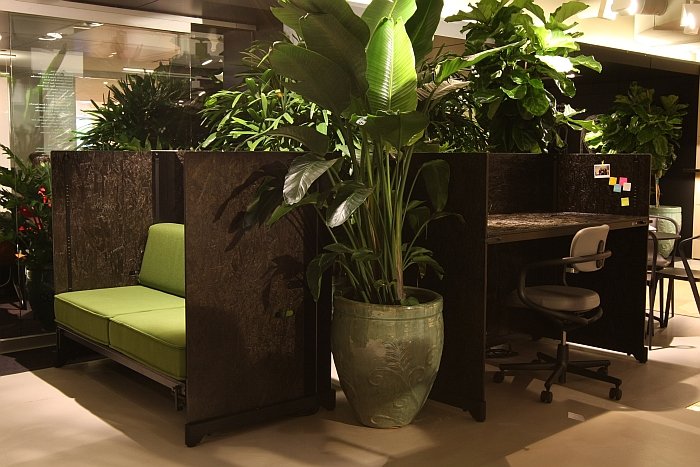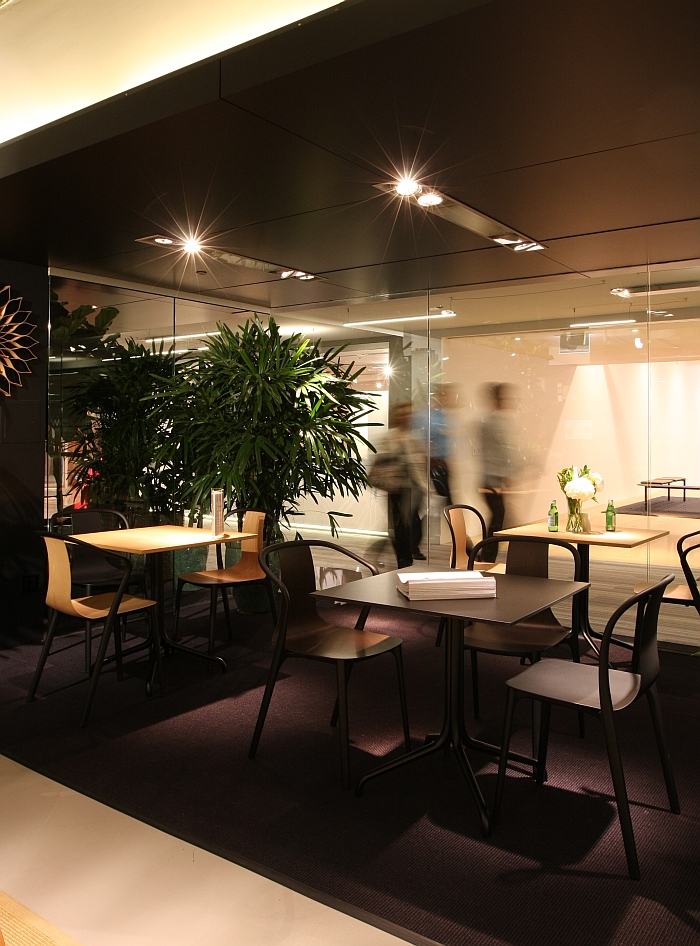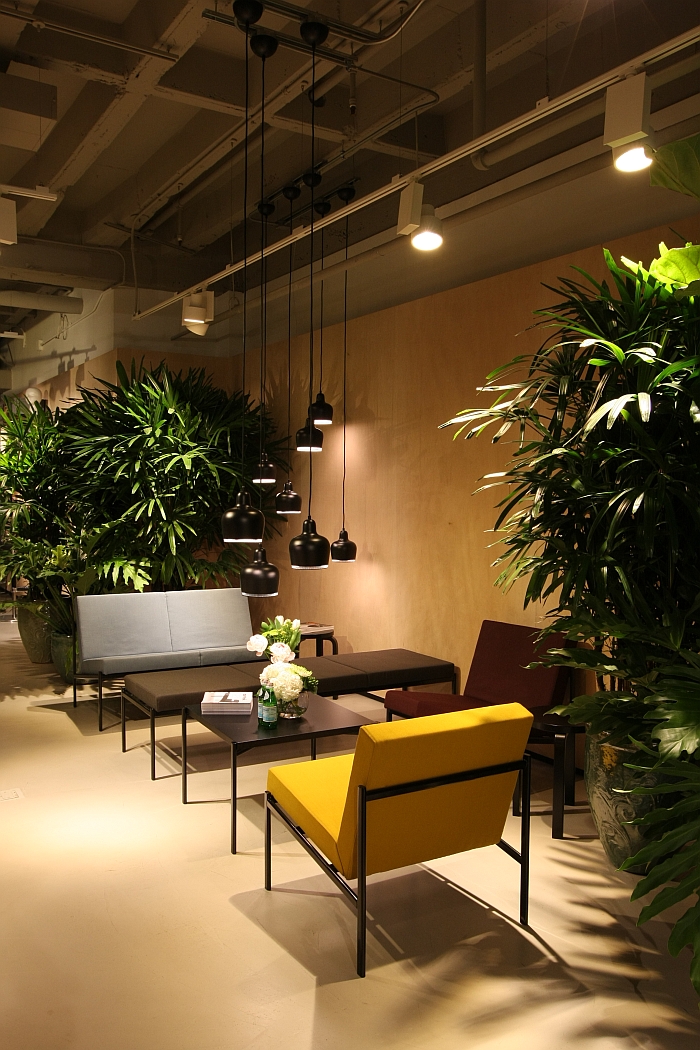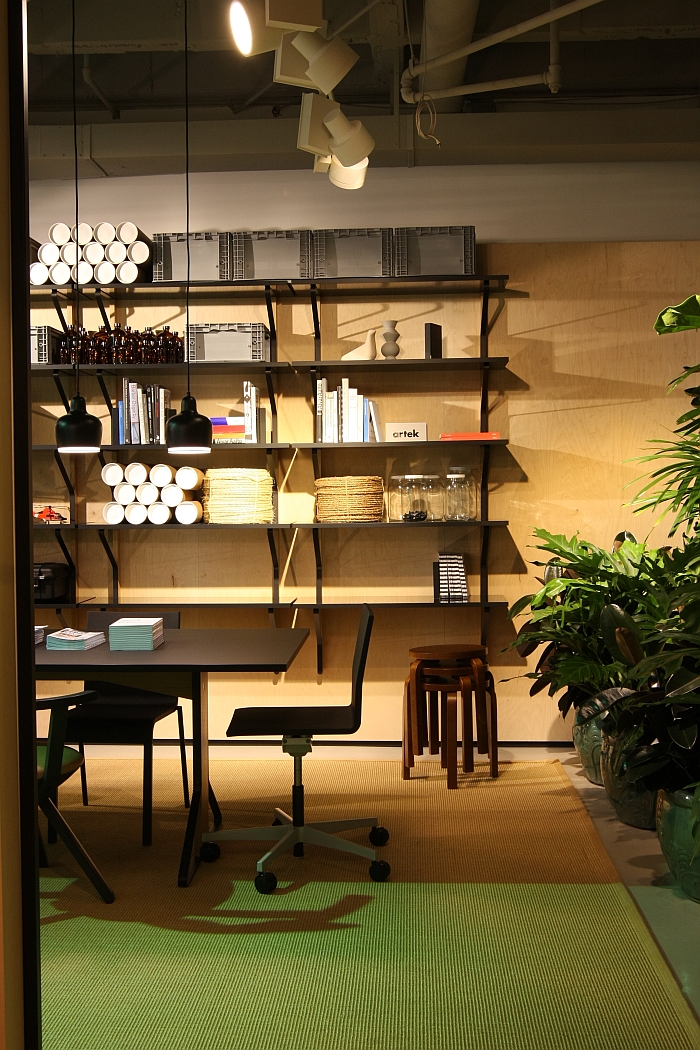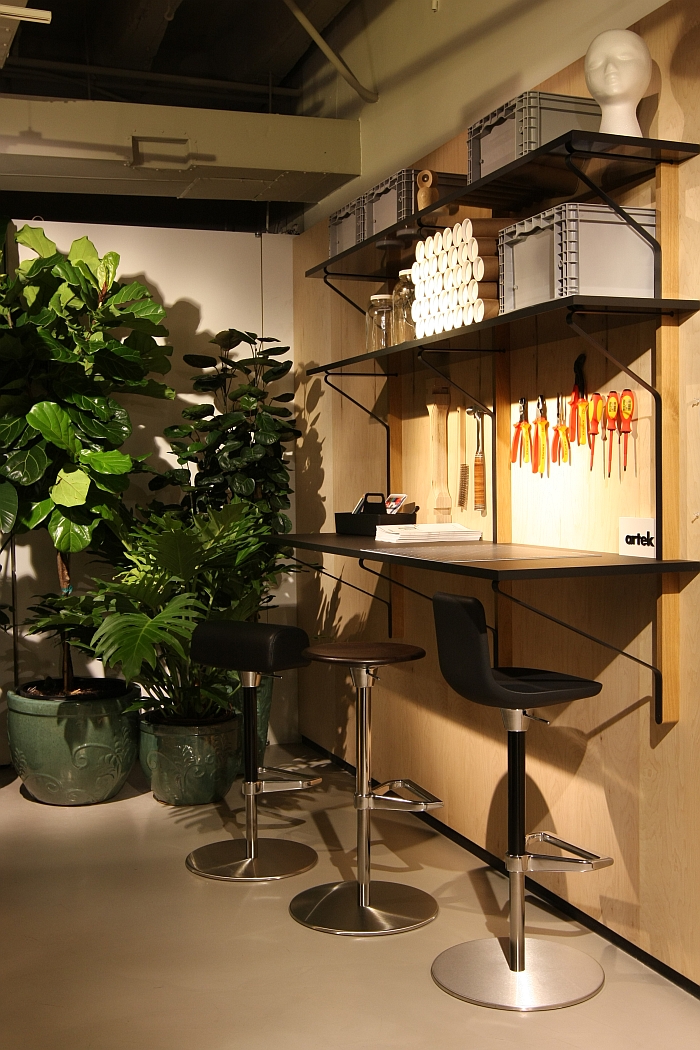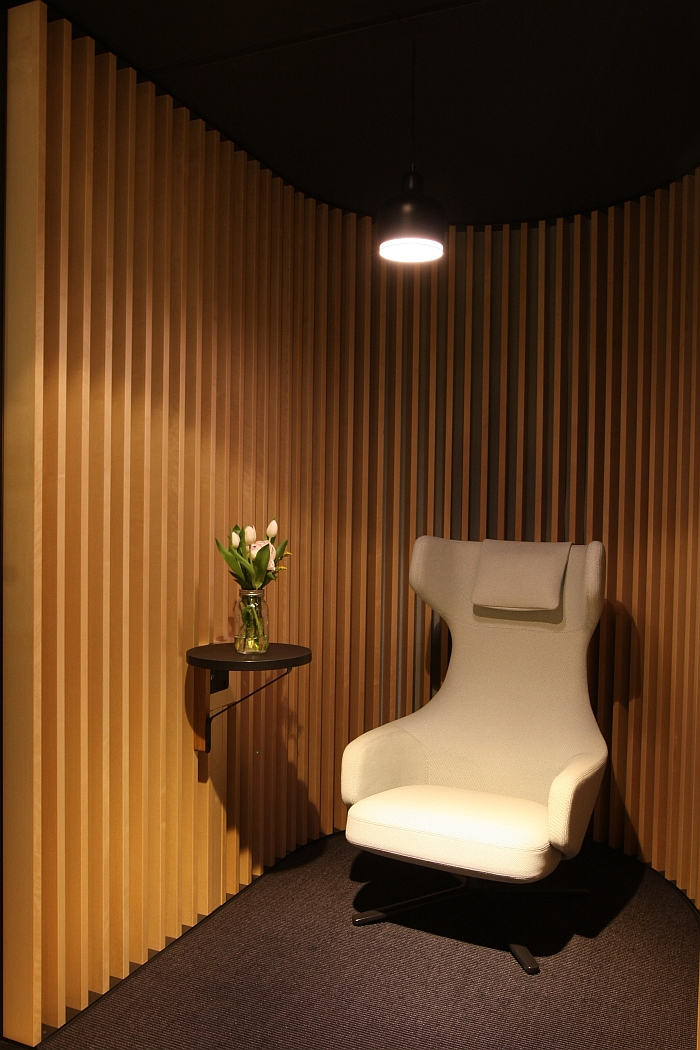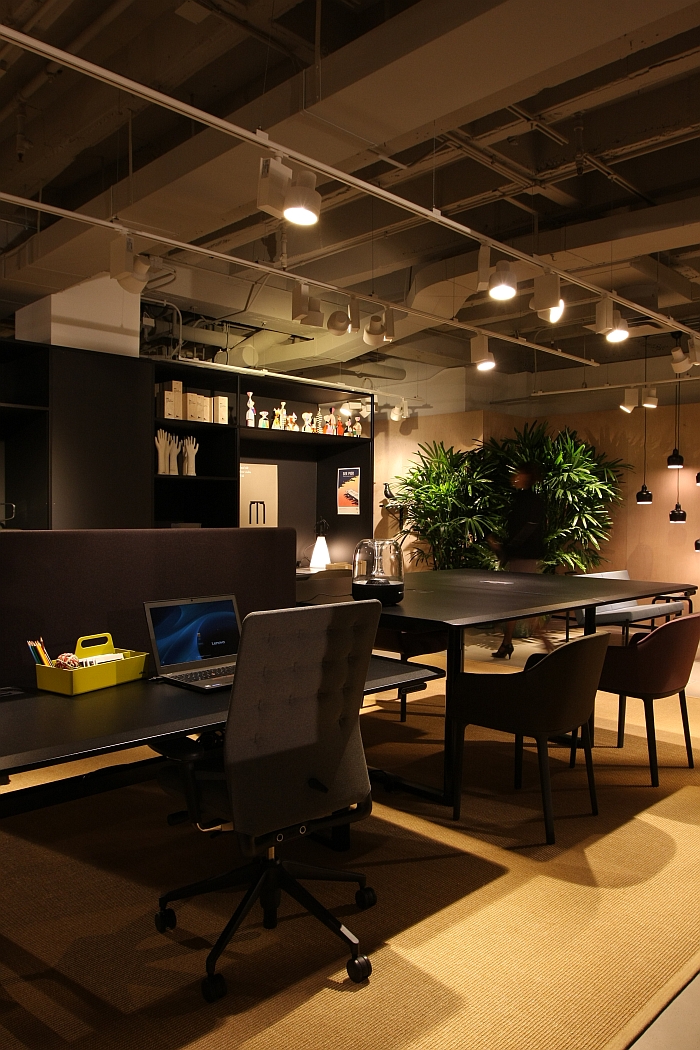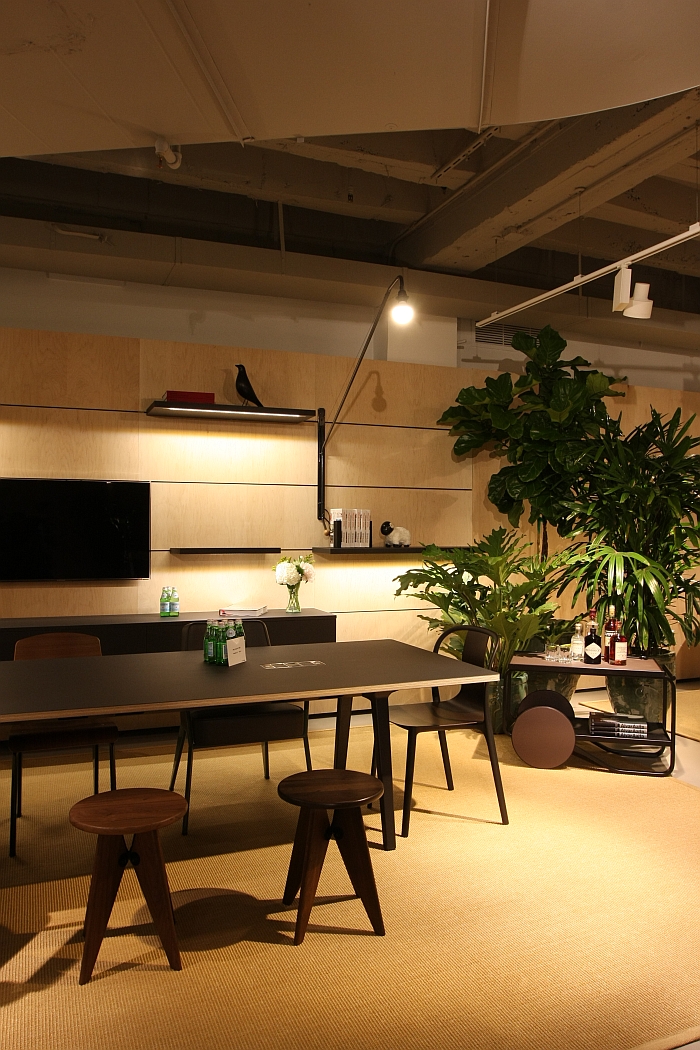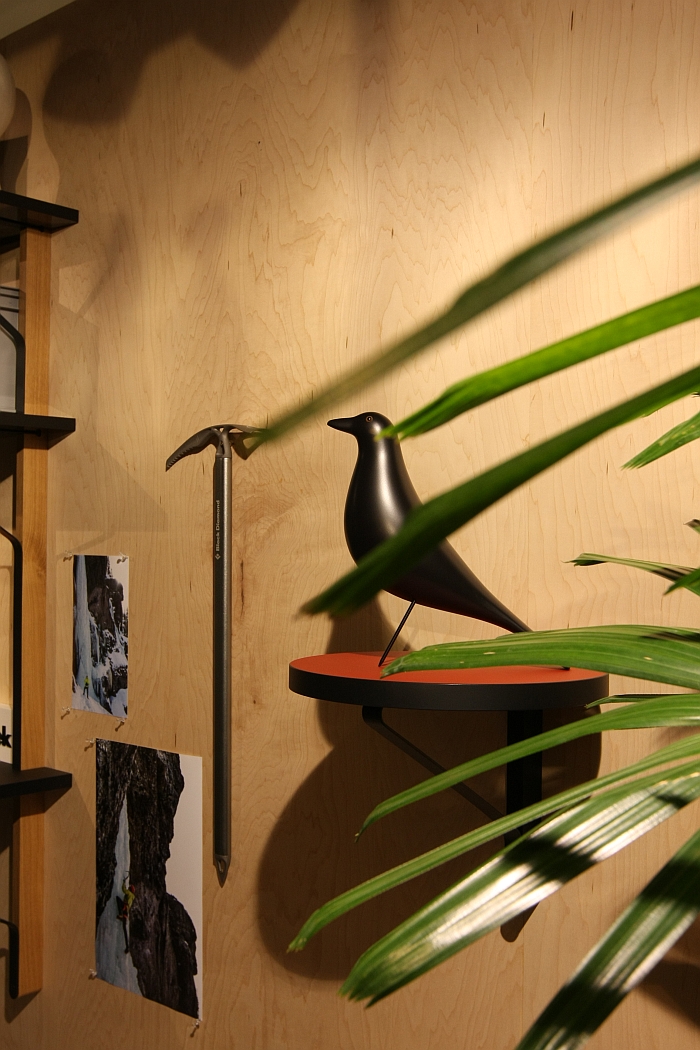Artek | Exhibitions and Shows | Interview | NeoCon | Office Furniture | Producer | Vitra
Although geographically the (hi)story of Vitra begins in Basel, spiritually it begins in America and arrives in Switzerland in 1957 with the licences to produce works by US designers such as Charles and Ray Eames, George Nelson, Isamu Noguchi and Alexander Girard; and then grows over the subsequent decades under the influence of the close co-operations which thus developed, for all those with George Nelson and Charles and Ray Eames.
Given this close affinity with and to America it was perhaps inevitable that Vitra would one day set their sights on the American market, in many ways it is and was a "home" market, and in the mid-1980s the first, tentative, American steps were undertaken; even if trading in America meant, and means, trading without the works of Eames, Nelson et al, the US production and distribution licences for such designers remaining with Herman Miller.
That Vitra began trading in American in the mid-1980s was arguably no coincidence: not only was that a period when Vitra was increasingly developing its own products, and thus moving away from its "American" origins, but the company was also in the process of adding a new string to its bow, office furniture. In 1976 the Vitramat by Wolfgang Müller-Deisig was Vitra's first self-developed office chair, and was closely followed by the Persona by Mario Bellini in 1979, Figura by Mario Bellini in 1984 and the AC 1 by Antonio Citterio in 1988, complimenting the office chairs came desk and storage systems such as Metropol by Bellini or Spatio from Citterio; while the 1993 research project and exhibition Citizen Office by and with James Irvine, Ettore Sottsass, Andrea Branzi and Michele De Lucchi marked Vitra's first attempt to define the demands of future office environments and saw the proposition of new office concepts and new office furniture typologies.
Thus Vitra entered the American market in the 1980s with its office furniture programme, established its reputation in America with its office furniture programme, and, somewhat unsurprisingly, the office and contract market remains a major focus of Vitra's American business and thus NeoCon Chicago one of the most important events for Vitra USA.
At NeoCon 2016 Vitra staged the American launch of both the Hack table system by Konstantin Grcic and the Belleville chair collection by Ronan and Erwan Bouroullec, while, and in nice demonstration of the closeness that exists between Artek and Vitra in the USA, also used NeoCon 2016 to launch the Bouroullec's Kaari Collection for Artek.
We took the opportunity afforded by NeoCon Chicago 2016 to meet up with Vitra's Chief Sales Officer, and former Vitra USA President, Josef Kaiser, to discuss the differences between the US and European markets, the challenges of the American market for a company such as Vitra, and life for Vitra without Eames et al, but began by asking how the situation in America has developed since Vitra took those first, tentative, US steps.....
Josef Kaiser: When Vitra first started trading in America it was somewhat difficult because in those days office systems were all about cubicles, and that wasn't a market we wanted to get involved in or with, and so our focus in the early years was purely office chairs. However, because we were here we have been able to play an active role in the development away from cubicles and towards open office concepts, and in particular in the last five years or so things have changed radically. The cubicles still exist, are still being installed, but you don't see them, for example, at fairs anymore, and more importantly attitudes are changing, are moving away from the fixed idea of the cubicle, and that means for us it is now much easier to talk to customers about the opening of the office environment, about flexible, variable office systems and the effect that can have on the office culture and workflows.
smow blog: And when you speak of "customers" is that companies directly, or do architects play a role in the American market?
Josef Kaiser: For us the market in America is much more dependent on architects than is the case in Europe. Here it is often the case that for any changes in an office an architect must be involved and that means that you generally always have an architect who specifies what is sourced and from whom. And in that sense a fair such as NeoCon is very important not only as an opportunity to present and explain our concepts, to explain the added value inherent in our office systems, but also in terms of establishing and developing relationships with architects.
smow blog: From which two questions arise, the first being does that mean in America the dealer network is less important for a company such as Vitra than in Europe or....
Josef Kaiser: ......no the dealers are still important, but it is a completely different culture. In America the dealers are often large corporations, at least in terms of the contract market, and there are numerous US dealers with turnovers of several hundred million dollars per year, which are scales we don't have in Europe. And whereas in Europe Vitra has a leading position in our market, in America we are one of a hundred or more suppliers, and so as a relatively small, European, manufacturer it isn't always easy to become established with American dealers.
smow blog: Which by extrapolation we presume means the main difference between NeoCon and Orgatec would be that here architects are the focus, whereas at Orgatec the main focus is the dealers and dealer networks?
Josef Kaiser: Exactly. Although that said at Orgatec 2016 we will be trying to be more interesting for architects, without losing the focus on the dealers, which will be challenge, but one we're looking forward to, not least because this year we have our own hall, something which also underscores the difference in the markets, here in Chicago we have 370 square metres and in Cologne our own hall.
smow blog: What? A whole hall? All by yourselves?
Josef Kaiser: We will be in Hall 5 this year, a new hall for Orgatec, one which is being opened specially for us, and no we won't be completely by ourselves, it will be a case of "Vitra + Friends".
smow blog: Very intriguing, but we suspect you're not going to tell us any more, and so let's return to America. Aside from hall sizes how do the figures compare, how large and/or important is the American market for Vitra?
Josef Kaiser: At the moment America represents around 7% of our total turnover, which for us is a good figure and importantly one which has potential for further growth. And to place it in context, the market in America is for us much smaller than say Germany or Switzerland, where in both countries we have more customers and more turnover than here in America. Which isn't to say America isn't an uninteresting market, just very challenging.
smow blog: And in terms of the split office/domestic....?
Josef Kaiser: Office is the majority. In Europe we sell, for example, a lot of Eames in the home market, which obviously we don't have here, while in terms of domestic furnishings not only is the nature of the market very different, but the tastes in furniture and interior design are very different from those in Europe, American's tend to buy different things in different ways, and so for us the home market represents around 15-20% of our American business. However in the home market we are also seeing changes and increasing numbers of Americans who are interested in contemporary European design and the home furnishing solutions Vitra offer.
smow blog: We've been talking about "America" in general, we would however assume the most important markets for Vitra are essentially the major centres, or.....?
Josef Kaiser: Not entirely, America is very interesting for us in coastal areas. New York is our main market and then it remains interesting along the east coast both north towards Boston and south towards Washington. In contrast the centre, including Chicago, is less interesting for us, here the markets are much more traditional and not necessarily so interested in contemporary design concepts; but then on the west coast, San Francisco, Los Angeles, but also further north Seattle, Redmond and on to Canada and Vancouver, then there is much more interest in both the sort of solutions Vitra can offer and also for contemporary European design.
smow blog: Purely on account of some of the towns you mentioned, we're assuming therefore that the creative industries, digital economy and similar branches are particularly relevant for yourselves?
Josef Kaiser: Very much so, and one particularly interesting example in that context is Austin, Texas, a relatively small city but one with lots of creativity, which is home to many creative individuals who are interested in and are looking for new ideas, and a city which is becoming ever more interesting for us and which offers more potential than many larger cities in the centre of the USA. However we also have a lot of customers in more traditional industries such as banking, pharmaceuticals or education where for all the adult education market, so colleges and universities, is very interesting for us.
smow blog: You stated a couple of times that the American market is "challenging", what are the particular challenges that you have over here, or perhaps better put, where does the American contract furniture market vary most from the European?
Josef Kaiser: I'd say there are three main areas. Firstly on account of the nature of rental contracts the planning horizon in America is relatively short, certainly in comparison to what we know in Europe. In America an office is rarely planned for more than seven years, our products have a much longer lifespan, and so we have a quality which is better than that which is required for the American market, and so we need to find premium customers who have an interest in a premium product. Similarly, as a country America is, generally speaking, one that tends to buy cheaply and which thinks and handles with a tendency towards a throwaway mentality, that is moving more towards sustainability, but very slowly. And thirdly the bond between employer and employee that we know in Europe isn't necessarily present in America. Employees don't necessarily associate themselves to a company, while many employers promote a hire and fire mentality, and this combination doesn't always result in positive, respectful, workplaces, and so not workplaces where much thought or attention is paid to the furniture. Consequently we need to find those companies where the opposite is the case and who are interested in developing a positive corporate culture.
smow blog: As you already mentioned, in America you can't sell Eames et al, which means you're, effectively, reliant, on European designers, does that pose a further challenge?
Josef Kaiser: Yes, very much so, but for us it also an excellent opportunity to prove ourselves in a market without Eames and Nelson, and thus to demonstrate that we can be successful without such classics. Classics are important and with the Prouvé collection we have a very interesting collection and one which is positively received in America, similarly with Artek and Alvar Aalto we now have designs which are very well known and well loved in America. However our main business in America is with contemporary European designers, the Bouroullecs, for example, are very important here, as are the products from Antonio Citterio or Alberto Meda, and so I see our success in America as evidence of the strength of the Vitra portfolio, and for all how the Vitra portfolio has positively developed in recent years through our focused co-operations with younger European design bureaus.
smow blog: Which is a nice link, European design vs American production. We know you have a facility in America, but do Vitra actually produce in America?
Josef Kaiser: We have a small plant in Allentown, Pennsylvania, where we undertake both final assembly and also local sourcing with the aim that 80% of our portfolio is either finished in America or the raw materials are sourced here. Products which require specialised manufacturing or where we simply don't sell in relevant quantities are then imported from Europe.
smow blog: Which naturally raises the question, why?
Josef Kaiser: The principle reason is to allow for flexibility. Delivery times are very important in America, and that generally means short delivery times, and when you solely import from Europe that is very difficult and so in that respect local production and local sourcing is important in order to respond to customers' demands.
smow blog: And from our European perspective on, let's say, American patriotism, we would imagine American's also favour "Made in America"? Or is there an appreciation of European production and European quality standards?
Josef Kaiser: One finds both, there are those customers who want European design produced with a European manufacturing quality, but then, and especially in corporate America, there are increasingly internal guidelines which state that "Americans buy American", and we can happily meet the demands of both groups.
smow blog: To end, the stand here is, let's say, very Artek heavy for a Vitra showroom, we're presuming this isn't a "Vitra + Friends" dress rehearsal, so why not two stands, why the integration?
Josef Kaiser: In Europe we separate the brands much more deliberately, and acutely, than in America, not least because the nature of the American market means that promoting two brands independently is much more challenging, even given the traditions and strengths of both Vitra and Artek. Consequently for us it was a logical decision to, as it were, present Artek under the Vitra brand, not least because of how such a presentation concept helps explain the ideas of collage and of mixing and integrating products which underlies the Vitra philosophy. Things are however now changing, and for example in our New York showroom we have begun to present Artek much more as a standalone brand, and I expect that in the future we will, in all probability, represent both brands independently at such fairs.
